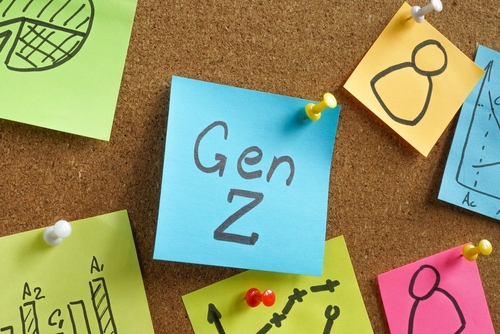Across the country, many companies are establishing return-to-work mandates. Driven by existing lease agreements and lingering suspicion that remote workers aren’t as productive as they claim, most companies are ignoring a critical flaw in their RTO strategy: maybe it’s not that employees don’t want to be in the office—they just don’t want to be in your office.
Data shows that as the pendulum is swinging back toward in-office work, workers across every generation overwhelmingly prefer a hybrid arrangement over fully remote work. The problem is, the offices they left five years ago when COVID hit haven’t changed, but workers’ expectations have.
Gen Z Leading the Charge
This is especially true among Gen Z—a key demographic that many companies are struggling to recruit. The fact that Gen Z will soon make up 30% of the workforce, outnumbering Gen X in the next five years, makes the challenge of appealing to Gen Z talent even more urgent.
According to Savills, Gen Z spends 12% more time working in the office compared to their older colleagues, they by far prefer a hybrid arrangement over fully remote. Perhaps because they’re also the loneliest generation, 1 in 4 Gen Z workers say they actually want less remote time (the highest percentage of any generation), contrary to most assumptions.
For HR, it’s a harsh reality that this generation knows they have options:
- They’re the most entrepreneurial, more comfortable with shunning traditional full-time employment in favor of freelance or gig work.
- Many already have side hustles they could easily turn into full-time self-employment.
- Skilled trades are attractive once again for their lucrative wages, with no need for a four-year degree and zero student loan burden.
As a result, Gen Z has a low tolerance for subpar work cultures and they’re quick to leave if the conditions aren’t satisfactory. Thanks to social media platforms such as Instagram and TikTok, they can easily see the dynamic spaces their peers enjoy, so they know exactly what they’re missing out on as they sit in a bland, uninspiring space.
Companies must refresh their workspaces to close the gap between expectation and reality. HR can play a strategic role in this process, evaluating the current environment and providing data-driven recommendations for workspace redesign that will support talent strategy today and down the road.
Gen Z’s Real Workplace Priorities: Office Design Essentials to Prioritize
In redesigning the workplace for Gen Z and beyond, here are the non-negotiables for creating an office space workers will want to return to.
- Employee input: The best way to find out what your employees want is to ask them. Before embarking on any redesign, conduct a thorough assessment of the current space and solicit employee insight on their ideal work environment. Consider focus groups or surveys to ask about their work habits, needs, and preferences.
- Integrated technology: These digital natives expect seamless tech integration, and cutting-edge connectivity is a crucial utility the same as electricity and water. Gen Z grew up with mobile phones and access to all the world’s knowledge in the palm of their hand. Cumbersome or lagging tech is an obstacle they won’t tolerate.
- Workspace variety: The banal, cubicle-farm office is dead. Certainly, you need collaborative spaces, but the auditory and visual distractions that come with some open concept spaces can deter focus and productivity. Junior team members are less likely to have a private office, and their home may be a shared environment, so they need quiet spaces for deep work. Dictating RTO from the luxury of a corner office while everyone else is stuck in a bullpen lacks empathy. Create options for private spaces or library-like quiet zones that minimize distractions.
- Flexible furniture and adaptable layouts. When working at home, employees can shift between a variety of work settings: a desk, the dining room table, the couch, an outdoor table. At work, offer the same flexibility with a variety of furniture and modular spaces. For example, conference spaces that can be divided with movable walls into breakout rooms or open spaces with couches, standing-height tables and chairs that can be pulled together for small group gatherings. This makes for a more comfortable environment that encourages movement and maximizes space efficiency and utilization.
- Inspired interiors: Gen Z is looking for purpose and meaningful work with a company culture that matches their values, and the aesthetic of the space must match the brand. They’re also exposed to a plethora of influences, so they see what’s out there and recognize that inspired spaces represent a company’s investment in its team.
One executive at a well-known tech firm confided that they were attracting lots of top-tier candidates for their many open positions but losing them after the interview, and many of their high-performers were leaving, too. A quick assessment revealed that the environment and tone of the office didn’t match the energy and excitement this award-winning brand portrayed.
Create your own authentic and intentional spaces with thoughtful aesthetics, biophilic elements, interesting artwork and decorative features that match the culture. Employees who love where they work will share it on their social platforms, turning them into willing brand ambassadors who can help with recruiting.
- Inclusive design: Awareness of neurodiversity is growing, and a one-size fits all approach to the workplace is not enough. Neurodiversity can bring valuable perspective to a team, however that depends heavily on having workspaces that work for everyone. Designing spaces that support individuals regardless of their differences and abilities is crucial, along with giving them autonomy and flexibility to choose spaces that match their need.
- Wellness and mental health support: Having thoughtful amenities is vital for this generation, which prioritizes mental health and will seek employers that recognize its role in overall health. Beyond on-site fitness centers and healthy food options, consider low-sensory zones, meditation/reflection rooms, and even “recharge” rooms for short naps. Outdoor walking paths, glass walls that open to outdoor terraces, and rooftop gardens provide opportunities for movement, clarity, and fresh air.
Embracing the Next-Generation Workplace
As the workplace demographic shifts quickly in favor of younger generations, HR must prioritize their needs to attract and retain talent, lower turnover cost, and maximize productivity and the employee experience—starting with better design. Companies that embrace this change now will thrive; those that don’t will struggle to compete.
But these improvements aren’t exclusively for Gen Z—everyone flourishes in a more invigorating environment that signals value and respect to all. Older generations will enjoy these amenities too but likey didn’t feel comfortable speaking up about it in the same way. Gen Z and the aftermath of COVID have ushered in a new era: We’re all done with the bland spaces, cubicle farms, harsh fluorescent lighting, lack of windows, and “assigned” spaces that make us feel trapped. It’s time for something smarter.
Sarah Davis is a Workplace Strategist at HED.




